Bon Dia! We Arrive in Portugal
October 5 - This morning we arrived at the old city of Oporto in northern Portugal at the mouth of the Douro River. Oporto is a very old city dating back to the 4th century Roman occupation when it was called "Portus Cale", from which the later name of Portugal is derived.
In 1387, Porto was the site of the marriage of John I of Portugal and Philippa of Lancaster, daughter of John of Gaunt' which
[Read More]
symbolized a long-standing military alliance between Portugal and England The Portuguese-English alliance in 1386 is the world's oldest recorded military alliance.
In the 14th and the 15th centuries, Porto's shipyards contributed to the development of Portuguese shipbuilding. It was also from the port of Porto that, in 1415, Prince Henry the Navigator (The son of John I of Portugal and Philippa of Lancaster) embarked on the conquest of the Moorish port of Ceuta, in northern Morocco. This expedition by the King and his fleet, which counted amongst others Prince Henry, was followed by navigation and exploration along the western coast of Africa, initiating the Portuguese Age of Discovery.

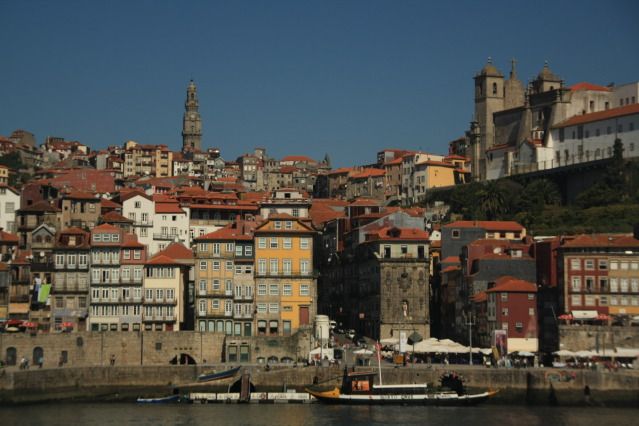
The first stop on our tour of the city was the Oporto Cathedral which began construction in 1110 and was completed in the 13th century.
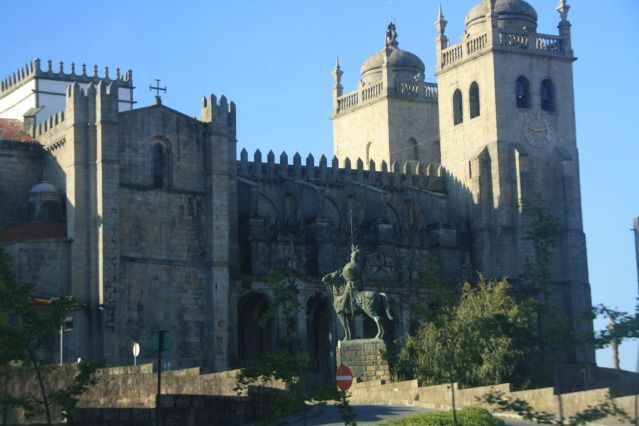
The Romanesque nave is rather narrow and is covered by barrel vaulting. It is flanked by two aisles with a lower vault. The stone roof of the central aisle is supported by flying buttresses, making the building one of the first in Portugal to use this architectonic feature.
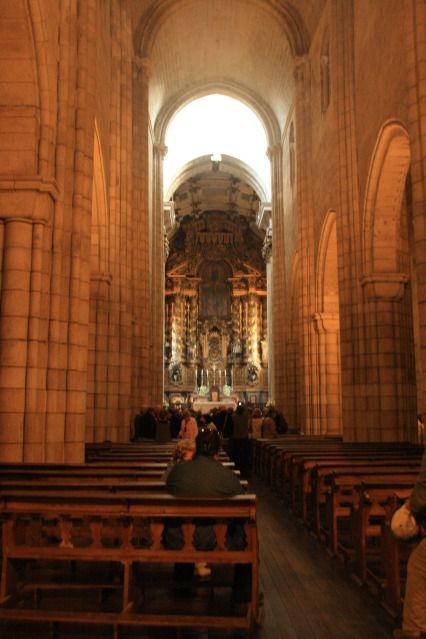

The altarpiece of the chapel, designed by Santos Pacheco and executed by Miguel Francisco da Silva between 1727 and 1729, is an important work of Portuguese Baroque.

From the cathedral proper we strolled through the lovely cloisters adjoining the main part of the building. Note how the walls are covered with blue and white ceramic tiles showing scenes from the Bible.




After our tour of the cathedral we took advantage of its location high up in the city to take pictures out over the town. Notice how some of the houses here are also heavily decorated with intricate ceramic tile such as that we saw back in Baiona.

And we sighted this local resident out for a morning stroll

Our next stop was at the Church of St. Francis (Igreja de Sao Francisco )The Franciscan Order was established in Porto around 1223. They began building the convent and a first, small church dedicated to Saint Francis of Assissi around 1244.
In 1383, under the patronage of King Ferdinand I, the Franciscans began to build a more spacious church. This new structure was finished around 1425 and followed a relatively plain Gothic design, typical for the mendicant in Portugal.

During the 15th and 16th centuries, prominent Porto families chose the Franciscan for their pantheon. The Chapel of St John the Baptist is a notable example, built in the 1530s for the Carneiro family in Manueline style, the Portuguese late Gothic. The main artistic campaign of the church was carried out in the first half of the 18th century, when most of the surfaces of the interior of the church, including walls, pillars, side chapels and roof, were covered with Portuguese gilt wood work (talha dourada) in Baroque style.
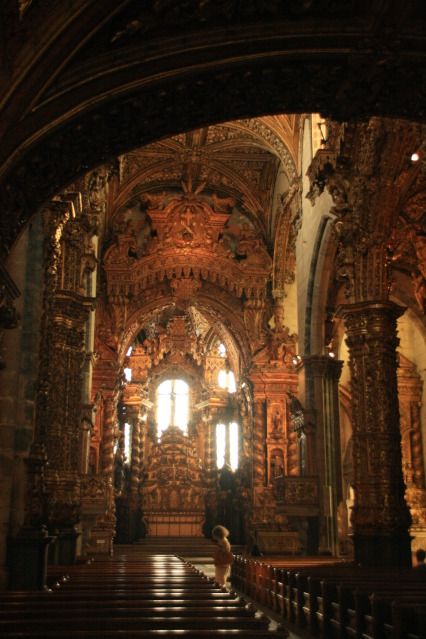
It seemed as though each noble family tried to out-do the other in terms of how much glitter they could add. While impressive I find that I prefer the simpler esthetic of the Romanesque and Gothic styles to all the gilt.
Of course one cannot visit Oporto without a visit to the Port houses for which the city is famous. The Duoro River valley was always a wine producing region. Grapes from the harvest were transported down the river to Oporto where they were processed and the wine was shipped overseas. Much of it was going to England. Unfortunately during transport the wine was often spoiled. So the Portugese came up with an idea to fortify the wine with a neutral grape spirit before aging. The process worked and Porto or Port became famous all over the world. It was so well liked in England that many of the current Port producers in Oporto are owned by English firms. Even in the Middle Ages the caves along the Duoro River were found to have an ideal mix of humidity and constant temperature for aging the Port.
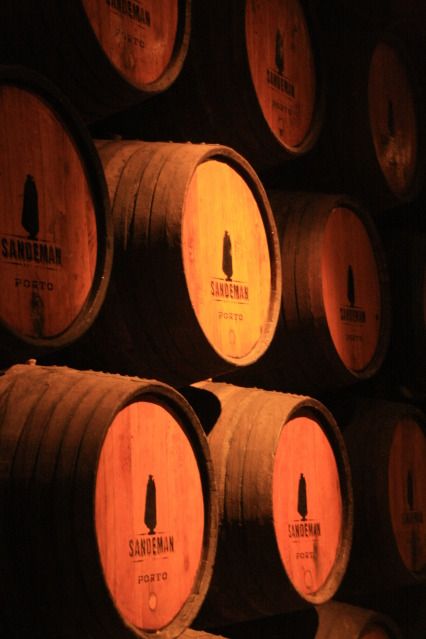
Most Port is aged in large barrels, however on occasion some is declared Vintage and stored away in single bottles, often for many years.
Vintage port is made entirely from the grapes of a declared vintage year and accounts for about two percent of overall port production. Not every year is declared a vintage in the Douro. The decision on whether to declare a vintage is made in the spring of the second year following the harvest. The decision to declare a vintage is made by each individual port house, often referred to as a "shipper".The port industry is one where reputations are hard won and easily lost, so the decision is never taken lightly.

Port comes in a number of different forms, the best known of which are ruby and tawny. More recently white and Rose Port has been added to the inventory. We were treated to samples of both a Tawny Port and a Vintage. The Tawny, which was a young Port was very good but with a bit of an alcohol burn. The Vintage was very smooth without any hint of alcohol burn and had lovely hints of plum and dark chocolate to it.
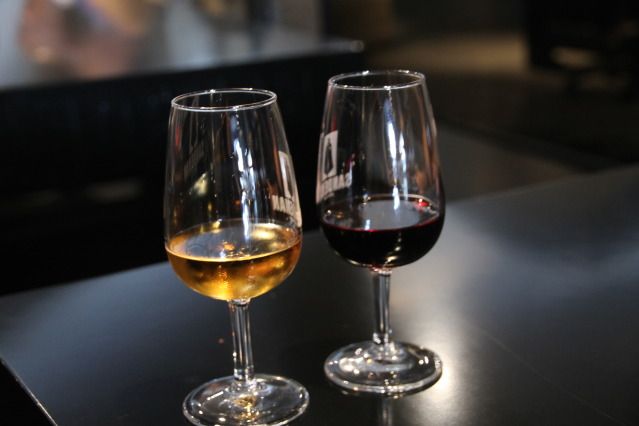
After our tasting we wandered down by the River Duoro where we found this gentleman who it appears also likes his port.
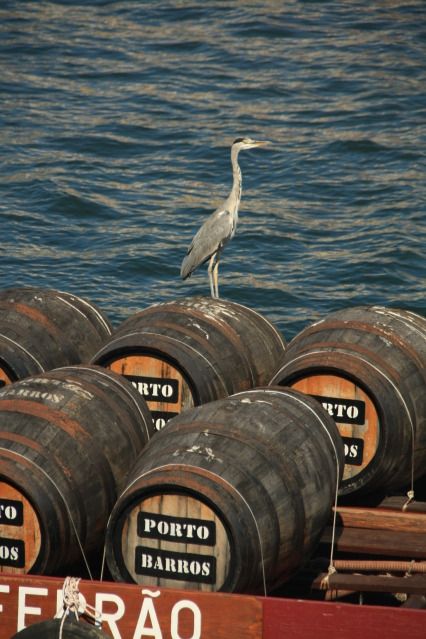
And a small group of fellows that looked like they had had a bit too much of the tasty Port and had broken into raucous song.

We finally re-boarded our buses and began to pack our bags for the sad end of our journey in Lisbon tomorrow.
In 1387, Porto was the site of the marriage of John I of Portugal and Philippa of Lancaster, daughter of John of Gaunt' which
[Read More]
symbolized a long-standing military alliance between Portugal and England The Portuguese-English alliance in 1386 is the world's oldest recorded military alliance.
In the 14th and the 15th centuries, Porto's shipyards contributed to the development of Portuguese shipbuilding. It was also from the port of Porto that, in 1415, Prince Henry the Navigator (The son of John I of Portugal and Philippa of Lancaster) embarked on the conquest of the Moorish port of Ceuta, in northern Morocco. This expedition by the King and his fleet, which counted amongst others Prince Henry, was followed by navigation and exploration along the western coast of Africa, initiating the Portuguese Age of Discovery.


The first stop on our tour of the city was the Oporto Cathedral which began construction in 1110 and was completed in the 13th century.

The Romanesque nave is rather narrow and is covered by barrel vaulting. It is flanked by two aisles with a lower vault. The stone roof of the central aisle is supported by flying buttresses, making the building one of the first in Portugal to use this architectonic feature.


The altarpiece of the chapel, designed by Santos Pacheco and executed by Miguel Francisco da Silva between 1727 and 1729, is an important work of Portuguese Baroque.

From the cathedral proper we strolled through the lovely cloisters adjoining the main part of the building. Note how the walls are covered with blue and white ceramic tiles showing scenes from the Bible.




After our tour of the cathedral we took advantage of its location high up in the city to take pictures out over the town. Notice how some of the houses here are also heavily decorated with intricate ceramic tile such as that we saw back in Baiona.

And we sighted this local resident out for a morning stroll

Our next stop was at the Church of St. Francis (Igreja de Sao Francisco )The Franciscan Order was established in Porto around 1223. They began building the convent and a first, small church dedicated to Saint Francis of Assissi around 1244.
In 1383, under the patronage of King Ferdinand I, the Franciscans began to build a more spacious church. This new structure was finished around 1425 and followed a relatively plain Gothic design, typical for the mendicant in Portugal.

During the 15th and 16th centuries, prominent Porto families chose the Franciscan for their pantheon. The Chapel of St John the Baptist is a notable example, built in the 1530s for the Carneiro family in Manueline style, the Portuguese late Gothic. The main artistic campaign of the church was carried out in the first half of the 18th century, when most of the surfaces of the interior of the church, including walls, pillars, side chapels and roof, were covered with Portuguese gilt wood work (talha dourada) in Baroque style.

It seemed as though each noble family tried to out-do the other in terms of how much glitter they could add. While impressive I find that I prefer the simpler esthetic of the Romanesque and Gothic styles to all the gilt.
Of course one cannot visit Oporto without a visit to the Port houses for which the city is famous. The Duoro River valley was always a wine producing region. Grapes from the harvest were transported down the river to Oporto where they were processed and the wine was shipped overseas. Much of it was going to England. Unfortunately during transport the wine was often spoiled. So the Portugese came up with an idea to fortify the wine with a neutral grape spirit before aging. The process worked and Porto or Port became famous all over the world. It was so well liked in England that many of the current Port producers in Oporto are owned by English firms. Even in the Middle Ages the caves along the Duoro River were found to have an ideal mix of humidity and constant temperature for aging the Port.

Most Port is aged in large barrels, however on occasion some is declared Vintage and stored away in single bottles, often for many years.
Vintage port is made entirely from the grapes of a declared vintage year and accounts for about two percent of overall port production. Not every year is declared a vintage in the Douro. The decision on whether to declare a vintage is made in the spring of the second year following the harvest. The decision to declare a vintage is made by each individual port house, often referred to as a "shipper".The port industry is one where reputations are hard won and easily lost, so the decision is never taken lightly.

Port comes in a number of different forms, the best known of which are ruby and tawny. More recently white and Rose Port has been added to the inventory. We were treated to samples of both a Tawny Port and a Vintage. The Tawny, which was a young Port was very good but with a bit of an alcohol burn. The Vintage was very smooth without any hint of alcohol burn and had lovely hints of plum and dark chocolate to it.

After our tasting we wandered down by the River Duoro where we found this gentleman who it appears also likes his port.

And a small group of fellows that looked like they had had a bit too much of the tasty Port and had broken into raucous song.

We finally re-boarded our buses and began to pack our bags for the sad end of our journey in Lisbon tomorrow.